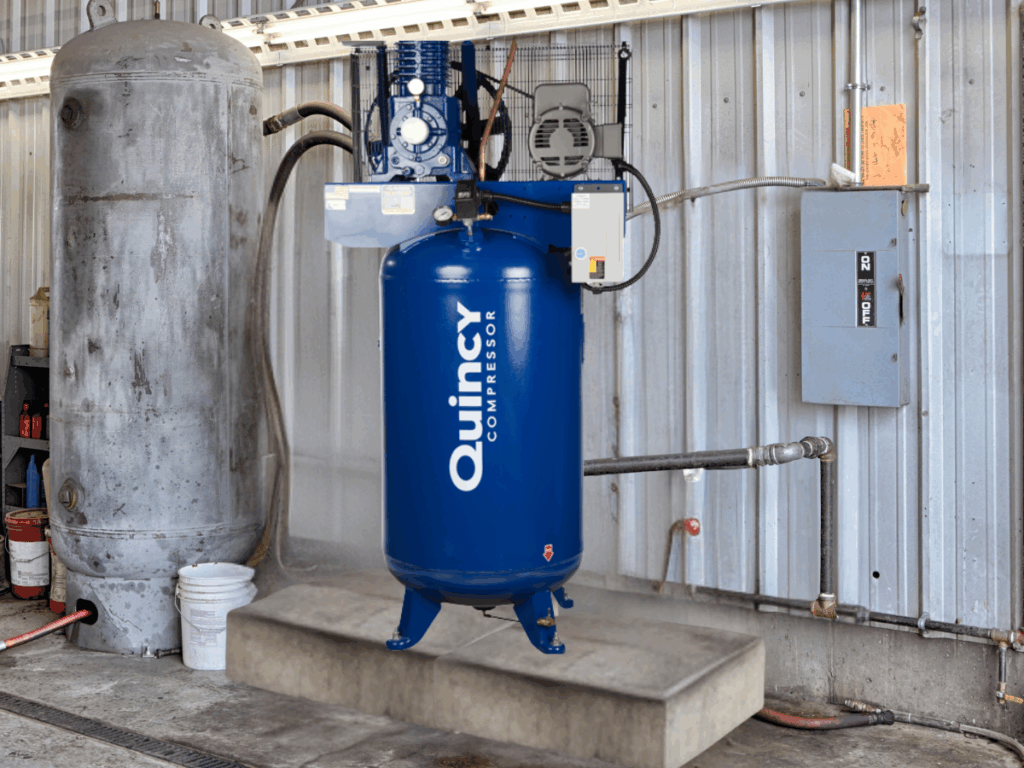Piston Compressor Not Working? Troubleshooting Common Failures
A malfunctioning air compressor equals costly downtime, but JHFOSTER is ready to help you diagnose the most common causes of piston air compressor failure and guide you on the next steps to get your operation back online.

Safety First: Before You Begin
Safety is essential when working on your air compressor, so it’s important to read the instruction manual and take the following precautions before you begin troubleshooting:
- Completely disconnect the air compressor from its power source.
- Wear appropriate personal protection equipment (PPE), including safety glasses and gloves.
- Release all stored air pressure from the tank by opening the drain valve.
- Make sure the relief valve functions properly.
- Ensure the compressor has cooled down if it was recently running.
Once you’ve established that the air compressor can be safely inspected, it’s time to start troubleshooting. The compressed air experts at JHFOSTER have outlined five common causes of piston air compressor failure and are standing by to help evaluate your system for issues that may impact performance and efficiency.
Problem: Compressor Won’t Start or Trips the Breaker
When the compressor won’t start or trips the breaker, potential causes can range from simple to more complex. If simple fixes don’t solve the problem, it may be a more complex issue that requires professional diagnosis and repair.
Check for these simple solutions first:
- Is the power switch on? Is the unit plugged in?
- Check your facility’s circuit breaker or fuse box.
- Ensure the tank pressure is below the cut-in pressure setting on the pressure switch.
More complex issues
Bad pressure switch: If the compressor won’t start, the switch may be defective.
Defective unloader valve: If the compressor trips the breaker only when the tank is pressurized, the unloader valve may be faulty.
Bad motor: If you notice a humming sound without turning, a burning smell or the compressor continuously trips the breaker, even with an empty tank, motor failure may be the issue.
Compressor has seized: Symptoms of this issue include a humming motor that doesn’t turn over and/or the inability to rotate the flywheel by hand (ensure the power is off).
Problem: Compressor Runs but Won’t Build Pressure
If the compressor is not generating enough pressure to achieve its normal PSI, reasons may include:
Air leaks: Air leaks are a likely cause of pressure loss. Air leaks force the compressor to run constantly to achieve the proper pressure. Finding and fixing air leaks is essential for efficiency and performance.
Dirty intake filter: A clogged filter restricts airflow into the pump, which can reduce pressure.
Worn pump components: Worn piston rings or damaged valve plates are common internal issues that prevent the pump from effectively compressing air. This usually requires a trained technician to diagnose and repair.
Problem: Compressor is Overheating, Stalling or Suddenly Stopping
Most air compressor motors have a thermal overload relay or switch that is designed to protect the compressor motor from damage caused by overheating, excessive current overdraw or mechanical malfunctions. Frequent tripping indicates underlying problems that should be addressed.
Common causes of overheating include:
- Poor ventilation around the compressor.
- Low oil level or incorrect oil viscosity.
- Dirt on exterior interior compressor components such as the intercooler, aftercooler or cooling fins of the compressor pump.
- Worn head gasket or valves.
- Insufficient air intake due to clogged filters.
Problem: Compressor is Leaking Oil or Using Too Much Oil
Oil-lubricated compressor failure may be related to issues with oil loss or aerosolized oil.
Causes of oil loss may include:
- Leaks from gaskets or seals.
- Using oil of the wrong viscosity. Manufacturers recommendations are usually based on ambient temperatures.
- Using an incorrect type of oil. Manufacturers recommendations vary from conventional to full synthetic.
- Oil “pull-through” where a clogged intake filter creates a vacuum that pulls oil from the crankcase.
- Oil carryover, caused by improperly seated (make sure to follow the manufacturers break-in procedure) or worn piston rings may cause the seal to break down and draw oil into the compressed air, resulting in oil loss or contaminated air.
Aerosolized oil caused by restricted air intake or worn piston rings is a troublesome issue that can also contaminate machine parts such as seals and plastics, as well as downstream pneumatic tools and accessories, and can negatively impact the quality of finished products. This should be addressed immediately.
Problem: Compressor is Excessively Loud or Vibrating
All compressors make noise during normal operation, but excessive noise or vibration indicates an issue.
Common causes for noise and vibration include:
- Loose belts, pulleys or belt guards.
- Worn bearings in the motor or crankcase.
- Loose mounting bolts or worn vibration pads.
- Internal pump damage, which requires immediate shutdown and attention.
When Replacement is Needed: Call JHFOSTER
Troubleshooting may reveal issues with simple remedies. However, if you find that that your piston compressor has worn beyond repair, JHFOSTER can help you find a replacement compressor that will provide reliable service and high levels of efficiency for years to come.
We supply the best industrial air compressors and system components to power your operations. With our solutions, companies experience less disruption, lower energy costs and improved efficiency. Contact a JHFOSTER expert today. We are standing by to evaluate your application and discuss your replacement options.
